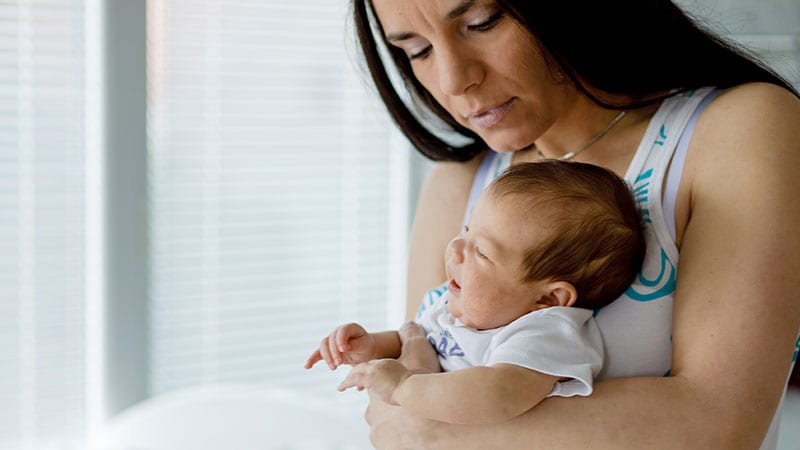Risk for severe maternal morbidity or mortality (SMM-M) is slightly lower among immigrant women than among nonimmigrant women, data suggest.
In a population-based study of more than 312,000 mothers from low-income urban areas of Ontario, Canada, the SMM-M rate among immigrants was 16.6 per 1000 births, compared with 17.1 per 1000 births for nonimmigrant mothers. Immigrants’ risk, however, varied by country of origin.

Jennifer Jairam
“These findings highlight the importance of designing prepregnancy, antenatal, and peripartum care initiatives that are inclusive of immigrant and nonimmigrant women alike who are residing in low-income neighborhoods,” write study author Jennifer A. Jairam, MSc, a PhD candidate in epidemiology in the Dalla Lana School of Public Health at the University of Toronto, and colleagues.
The findings were published February 16 in JAMA Network Open.
Variation by Nationality
Maternal morbidity and mortality are important indicators of public health and the quality of healthcare. Although living in a low-income area and migration are associated with adverse pregnancy outcomes, no previous studies had compared the risk for SMM-M among immigrant and nonimmigrant women in low-income neighborhoods, according to the authors.
To examine this question, the investigators conducted a Canadian population-based cohort study. They examined administrative health data collected by the research institute ICES from April 2002, to December 2019. In their study, the researchers included 414,337 hospital singleton live births and stillbirths occurring between 20 and 42 weeks’ gestation among residents of urban Ontario neighborhoods in the lowest income quintile. All women were covered by universal healthcare insurance.
The cohort included 148,085 births to nonrefugee immigrant women with a mean age at index birth of 30.6 years. It also included 266,252 births to nonimmigrant women with a mean age at index birth of 27.9 years. Nonimmigrant women were more likely to be nulliparous and have infants with higher birth weight.
Most immigrants originated from South Asia (35.4%) and the East Asia and Pacific region (23.8%). Three quarters of the immigrant women had resided in Ontario for less than 10 years. The most frequent SMM indicators were postpartum hemorrhage with red blood cell transfusion, ICU admission, and puerperal sepsis.
Compared with nonimmigrants, the risk for SMM-M among immigrants was equivalent to an adjusted relative risk (aRR) of 0.92 and an adjusted absolute risk difference of −1.5 per 1000 births.
For immigrant women, the adjusted odds ratio (OR) of having one SMM indicator was 0.92, compared with nonimmigrant women. Immigrants had an adjusted OR for two SMM indicators of 0.86. Risk for three or more indicators (OR, 1.02) was not lower among immigrants, however.
The lowest aRRs for SMM-M were observed in mothers from Western nations and Europe (0.73), East Asia and the Pacific (0.83), and South Asia (0.84). But aRRs were higher among women from the Caribbean (1.35) and sub-Saharan Africa (1.38). Among the top 10 countries by maternal birthplace, the highest aRRs for SMM-M were observed for women from Ghana (1.67), Jamaica (1.50), and Bangladesh (1.43). Those from Sri Lanka, China, and India were at significantly lower risk than Canadian-born women.
Healthy Immigrant Effect
“Efforts aimed at improving pregnancy care should be inclusive of both immigrant and nonimmigrant women residing in low-income neighborhoods,” Jairam told Medscape Medical News . “To achieve this, more details are needed about the characteristics and needs of various immigrant groups and women who have lived in a low-income area for more than one generation.”
Senior author Joel G. Ray, MD, an internist at St. Michael’s Hospital in Toronto, told Medscape that previous research has examined outcomes among mothers of various income levels and immigrants of various origins. This study, however, is the first to focus on outcomes in low-income neighborhoods and to examine differences in immigrant groups within those residential areas by maternal birthplace, he said.
“Since existing research has not been confined to low-income areas, it may not have effectively disentangled the influence of area-level income from that of being a new immigrant who may settle in a low-income area, or a nonimmigrant female living in poverty,” said Jairam.
Although details on lifestyle, income, and education were not available in the database, the findings support the so-called “healthy immigrant effect.” Said Ray, “Many people immigrate not because of adversity but because they see opportunity.” While they may settle in low-income areas at first, “they may have attributes associated with higher income such as better health practices and better measures of physical and mental well-being.”
The healthy immigrant effect hypothesizes that more resilient people tend to migrate and that immigration policies in the host country select immigrants with these characteristics, said Jairam. But while recent or first-generation immigrants tend to be healthier than native-born individuals in the host country, this initial advantage disappears with increased duration of residency.
“A Huge Sample”

Dr Marianne Vidler
Commenting on the study for Medscape, Marianne Vidler, PhD, MPH, assistant professor of obstetrics and gynecology at the University of British Columbia in Vancouver, called the database study helpful from the clinical care and policymaking perspectives. “The researchers looked at a huge sample, which would not be possible in a prospective study, and it looked in a nuanced way at outcomes among different immigrant groups.”
Vidler, who was not involved the research, said the study’s striking finding of intergroup differences by country “highlights the need for collecting more granular data on country of origin to identify immigrant groups at higher risk to improve their clinical care.”
This study was supported by ICES, which is funded by the Ontario Ministry of Health and the Ministry of Long-Term Care. It also received funding from the PSI Foundation. Jairam, Ray, and Vidler report no relevant financial relationships.
JAMA Netw Open. Published February 16, 2023. Full text
Diana Swift is a medical journalist based in Toronto, Canada.
For more news, follow Medscape on Facebook, Twitter, Instagram, YouTube, and LinkedIn
Source: Read Full Article
